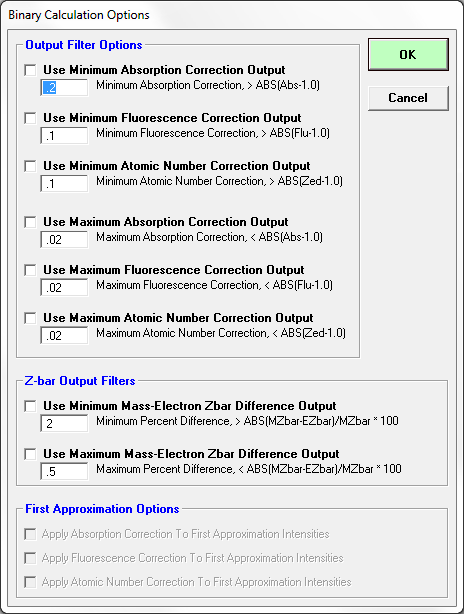Does anyone know of a paper that compares Armstrong matrix correction with PAP and XPHI. In Pouchou & Pichoir (1991) (Heinrich green book) - we have 826 dataset - and is tested on following
and Merlet (1994) tried his XPHI model
But none compare Armstrong
I notice in calczaf you can do histogram using Pouchouz10 - but this has 91 analyses - what is this?
I'm guessing Armstrong is good for geological samples - as it was developed and tested for them Armstrong (1988) but maybe not as good across the whole range??
Hi Ben,
I see Owen answered your question on changing the default correction in PFE and CalcZAF from the probewin.ini file.
Paul Carpenter can provide the exact details but here is what I remember: the Armstrong phi/rho/z was only published in this paper:
Armstrong, J. T. "Quantitative analysis of silicate and oxide minerals: a reevaluation of ZAF corrections and proposal for new Bence-Albee coefficients." Microbeam Analysis 19 (1984): 208-212.
but it was just a tweak of two existing corrections (Brown and another I think), where John Armstrong noticed that with his silicate (Shaw) k-ratio dataset (see shaw.dat attached below), he found that one phi/rho/z gave slightly "high" results and another gave slightly "low" results, and then he noticed that the only difference between the two corrections was an exponent in one term. So Armstrong "split the difference" with the two exponent values and got good results, at least with his shaw k-ratio data set.
Now you should be careful using any correction method which was "tuned" to a particular dataset, and that goes for the Pouchou k-ratio dataset as well. Because Pouchou tuned the XPP and PAP corrections to the Pouchou dataset, (using the Bastin MAcs) you will always get the best results on the Pouchou dataset using the XPP or PAP corrections.
Best to try several different datasets, see attached below. The Pouchou.dat dataset is the original dataset I got from Armstrong many years ago. The Pouchou2.dat dataset is an "extended" version I got from Philippe Pinard and Hendrix Demers. The POUCHOU2_wo_B_wo_Cu_La.DAT dataset is the Pouchou2.dat dataset *without* the boron and Cu L k-ratios which are affected by chemical shifts.
john
PS Yes, the Pouchouz10.dat dataset is a subset of the Pouchou dataset where the atomic number correction (Z) is greater than 10%. These types of subset output can be generated in CalcZAF using the filter options in the Analytical | Binary Calculations Options menu dialog as shown here:

The NISTBIN and Pouchou.dat datasets should be included with the normal CalcZAF installation, but maybe not the new Pouchou2.dat.